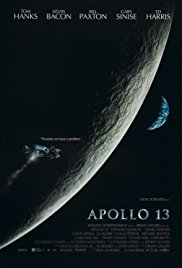In 1961 President Kennedy committed the United States to a program to put a man on the moon by 1970. His purpose was to provide a clear goal in the American effort to surpass the Soviet space program. The Apollo program landed six space ships on the moon beginning with Apollo 11 on July 16, 1969. Three of the missions, Apollo 14, 16, and 17, were extended stays on the surface of the moon in which the astronauts used a two-man Lunar Roving Vehicle to cross the Moon’s surface.
During the busiest years of the Apollo program, NASA had 36,000 permanent employees, 376,700 contract employees, and a yearly operating budget of $5.2 billion. The U.S. spent 25 billion dollars on the Apollo program. No other country has landed a man on the moon. In 1972, most of its goals having been accomplished, the Apollo program was abandoned so that NASA could concentrate on the space shuttle.
Apollo 13, launched on April 11, 1970, was crewed by James A. Lovell, Jr., John L. Swigert, Jr. and Fred Wallace Haise, Jr. As the space ship was preparing to begin lunar landing operations, an explosion occurred in the Command and Service Module (CSM). The ship lost oxygen. Electrical power and other systems were damaged. The abort systems intended to permit an emergency return to earth were knocked out.
To preserve power, the crew retreated to the Lunar Module and deactivated the systems in the CSM. The Lunar Module had no heat shield and therefore could not be used for re-entry into the earth’s atmosphere. After several harrowing experiences, including almost freezing to death and being nearly asphyxiated by carbon dioxide, enough power was found to use the CSM for reentry.
Later, it was found that the cause of the loss of the spacecraft was an explosion that occurred because of a defective wire connecting a fan used to stir liquid oxygen. The insulation on the wire burned, triggering the explosion. No astronaut was at fault.
An ampere (“amp” for short) is a unit used to measure the flow of electrical current, i.e., the number of electrons passing a certain point each second. The batteries in the CSM had been damaged in the explosion and were generating only a small portion of their usual power. Using a flight simulator, Ken Mattingly and the NASA engineers measured the number of amps that each of the reentry procedures required and found a way to steer the spacecraft through reentry with the limited amount of power left in the CSM’s batteries.
Apollo was a Greek God, the son of Zeus and Leto. Second in power only to Zeus, he gave life and light through the power of the sun. He was the God of masculine beauty, patron of the arts, god of music, poetry and the healing arts. He was the purifier of those stained by crime. The Romans adopted Apollo, worshiping him as the god of healing and of the sun.


